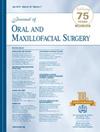Perineural Invasion and Lymph Node Ratio Quartile Are Associated With Extranodal Extension in Oral Cavity Squamous Cell Carcinoma
IF 2.6
3区 医学
Q2 DENTISTRY, ORAL SURGERY & MEDICINE
引用次数: 0
Abstract
Background
In contrast to extranodal extension (ENE), tumor characteristics can often be evaluated preoperatively in patients with oral cavity squamous cell carcinoma (OCSCC). If correlations exist between primary tumor characteristics and the presence of ENE, evaluating these factors could help provide more accurate patient counseling and adjuvant treatment planning before undergoing surgical therapy.
Purpose
The study’s purpose was to identify associations between OCSCC pathologic characteristics and ENE.
Study Design, Setting, Sample
We performed a retrospective cohort study of adult patients who underwent upfront curative-intent surgery for OCSCC at the University of Iowa Hospitals and Clinics from 2004 to 2018. The treating service was Otolaryngology-Head and Neck Surgery. Exclusion criteria included patients who did not undergo neck dissection, primary tumor occurring outside the oral cavity, pathologic N0, cancer previously treated with radiation or surgically at another institution, and gross disease remaining after surgery.
Predictor Variable
The predictor variable was a set of tumor characteristics, including oral cavity subsite, T- and N- classification, perineural invasion (PNI), lymphovascular invasion, bone invasion, and positive lymph node ratio (LNR).
Main Outcome Variable
The main outcome variable was ENE status, defined as positive (at least 1 lymph node reported to have ENE) or negative, identified from pathology reports.
Covariates
Covariates included subject sex, age, and smoking history.
Analyses
Bivariate comparisons and multivariate logistic regression analyses were performed to identify correlations between predictor variables/covariates and presence of ENE. Statistical significance was set at P = .05.
Results
The sample comprised 233 subjects with a mean age of 60.5 (SD 12.5) years, and 154 (66.1%) were male. Of 233 subjects with nodal metastasis, 122 (52.4%) had ENE in at least 1 node, and the median (interquartile range) positive LNR was 0.083 (0.094). On bivariate analysis, PNI (relative risk = 1.49; 95% CI, 1.14 to 1.96; P = .002), bone invasion (relative risk = 1.42; 95% CI, 1.13 to 1.80; P = .005), LNR quartile (P < .001), and pathologic T-class (eighth edition; P = .001) were significantly correlated with ENE. On multivariate logistic regression analysis, PNI (odds ratio = 2.29; 95% CI, 1.21 to 4.31; P = .01) and LNR quartile (P < .001) remained significantly correlated with ENE.
Conclusions and Relevance
This study offers insight into important clinicopathologic details of lymph node metastases in OCSCC with an emphasis on tumor characteristics and odds of ENE in 1 or more lymph nodes. This information may be beneficial for patient counseling and treatment planning, especially in patients with PNI and high positive LNR but no evidence of obvious ENE before surgery.
口腔鳞状细胞癌的神经周围浸润和淋巴结比例四分位数与结外扩展有关。
背景:与结外扩展(ENE)相比,口腔鳞状细胞癌(OCSCC)患者的肿瘤特征通常可以在术前评估。如果原发肿瘤特征与ENE存在相关性,评估这些因素有助于在接受手术治疗前提供更准确的患者咨询和辅助治疗计划。目的:该研究的目的是确定OCSCC病理特征与ENE之间的关系。研究设计、环境、样本:我们对2004年至2018年在爱荷华大学医院和诊所接受OCSCC前期治疗目的手术的成年患者进行了回顾性队列研究。治疗服务是耳鼻喉头颈外科。排除标准包括未进行颈部清扫、原发肿瘤发生在口腔外、病理no、既往在其他机构接受过放疗或手术治疗的癌症以及术后遗留的严重疾病。预测变量:预测变量为一组肿瘤特征,包括口腔亚位、T-和N-分类、神经周围浸润(PNI)、淋巴血管浸润、骨浸润和淋巴结阳性比率(LNR)。主要结局变量:主要结局变量为ENE状态,定义为阳性(至少1个淋巴结报告有ENE)或阴性,由病理报告确定。协变量:协变量包括受试者性别、年龄、吸烟史。分析:进行双变量比较和多变量逻辑回归分析,以确定预测变量/协变量与ENE存在之间的相关性。差异有统计学意义,P = 0.05。结果:样本共233例,平均年龄60.5岁(SD 12.5),其中男性154例(66.1%)。在233例淋巴结转移患者中,122例(52.4%)至少有1个淋巴结发生ENE, LNR中位数(四分位间距)为0.083(0.094)。双因素分析显示,PNI(相对风险= 1.49;95% CI, 1.14 ~ 1.96;P = .002),骨侵犯(相对风险= 1.42;95% CI, 1.13 ~ 1.80;结论和相关性:本研究提供了OCSCC淋巴结转移的重要临床病理细节,重点是肿瘤特征和1个或更多淋巴结中ENE的几率。这些信息可能有助于患者咨询和治疗计划,特别是对于PNI和LNR高阳性但术前无明显ENE证据的患者。
本文章由计算机程序翻译,如有差异,请以英文原文为准。
求助全文
约1分钟内获得全文
求助全文
来源期刊

Journal of Oral and Maxillofacial Surgery
医学-牙科与口腔外科
CiteScore
4.00
自引率
5.30%
发文量
0
审稿时长
41 days
期刊介绍:
This monthly journal offers comprehensive coverage of new techniques, important developments and innovative ideas in oral and maxillofacial surgery. Practice-applicable articles help develop the methods used to handle dentoalveolar surgery, facial injuries and deformities, TMJ disorders, oral cancer, jaw reconstruction, anesthesia and analgesia. The journal also includes specifics on new instruments and diagnostic equipment and modern therapeutic drugs and devices. Journal of Oral and Maxillofacial Surgery is recommended for first or priority subscription by the Dental Section of the Medical Library Association.
 求助内容:
求助内容: 应助结果提醒方式:
应助结果提醒方式:


